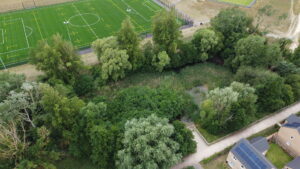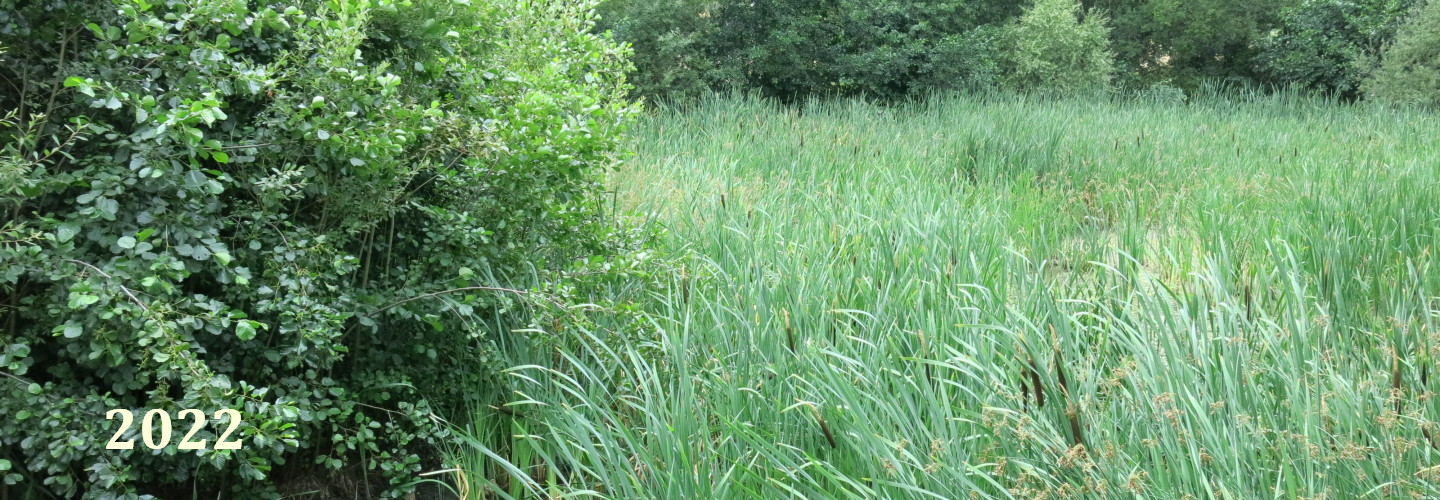Longstanton’s groundwater crisis has been a long time in the making. Hilary Stroude and Tony Cowley, writing for the Longstanton & District Heritage Society, first raised the alarm about declining pond and well water levels in the village magazine Longstanton Life way back in 2016 – just a few months after dewatering started on the Northstowe site.
In this article, we will trace the timeline of warnings issued. The question is: why has no notice ever been taken by the people who make decisions?
 February 2016: “Longstanton residents should be aware of a very real problem that lies beneath their feet!”
February 2016: “Longstanton residents should be aware of a very real problem that lies beneath their feet!”
LDHS highlights the issue of considerable and mysterious drops in the water levels of the Kingfisher Pond and other ponds in the village – just a few months after dewatering at Northstowe Phase I began. Warnings given in this article, written more than six years ago, have proved unfortunately accurate.
Read the full article here.
 April 2016: “The pond is a good three feet lower than it should be.”
April 2016: “The pond is a good three feet lower than it should be.”
Longstanton Life first publishes LDHS photographs showing the obvious effects of water loss on just one of the village’s struggling ponds and on a well at the family farm of Clive Hayden.
Read the full text here.
 December 2016: “Concern has been expressed that dewatering of Phase 1 Northstowe is continuing to have serious effects on lowering the water table in parts of Longstanton village.”
December 2016: “Concern has been expressed that dewatering of Phase 1 Northstowe is continuing to have serious effects on lowering the water table in parts of Longstanton village.”
Tony Cowley wrote:
Concern has been expressed that dewatering of Phase 1 Northstowe, in the golf course area, is continuing to have serious effects on lowering the water table in parts of Longstanton village. Anyone that has any doubts that the water levels for this time of year in their wells, local ponds or ditches are abnormally low, please contact LDHS using our usual contact details given below. We are collecting evidence on this subject (for or against) from residents, either in photographic or written form, detailing location.
 December 2017: “By all recent accounts [the Kingfisher] pond has been decimated; now virtually empty, its small fish — the food for the Kingfisher — killed, vegetation is now reclaiming it.”
December 2017: “By all recent accounts [the Kingfisher] pond has been decimated; now virtually empty, its small fish — the food for the Kingfisher — killed, vegetation is now reclaiming it.”
LDHS recounts the tragedy of the Kingfisher pond, once a thriving natural habitat and breeding location for rare and protected Kingfishers, and asks the question: “Has this all been caused by the dewatering of the area to provide adequate drainage for the Phase 1 development?”
Read the full article here.
 February 2018: “Northstowe: Eco-Town or Eco-Disaster?”
February 2018: “Northstowe: Eco-Town or Eco-Disaster?”
Two years after anxiety was first expressed about Longstanton’s dwindling groundwater, LDHS describes the further degradation of our ponds and the lack of response from official bodies with a duty of care. Despite ample evidence on the ground, South Cambs District Council’s planners, Ecology Officers and planners had failed to act. The article also asks the question: if drainage faults on Phase I of Northstowe have caused the calamity we already face, how much worse could things get after Phase II, with its drainage system designed along the same lines?
Read the full article here.
 April 2018: “Northstowe Phase 1 appears to have inflicted a level of environmental damage on Longstanton village and our natural ponds and wells that we could never have envisaged when this ‘exemplar’ eco-town was first proposed.”
April 2018: “Northstowe Phase 1 appears to have inflicted a level of environmental damage on Longstanton village and our natural ponds and wells that we could never have envisaged when this ‘exemplar’ eco-town was first proposed.”
The preservation of the Kingfisher Pond had been a condition of the granting of the planning permission for Northstowe. By April 2018, the village was waiting to see whether promised enforcement action would be taken by South Cambs District Council against the Northstowe developers if the Kingfisher Pond had not “fully normalised” by the end of the month…
Read the full article here.
 August 2018: “A local agriculturist, whose livelihood depends on the availability of a constant supply of water from his licensed well… has had to adapt to the reduction in his water supply by laying off two greenhouses. He also reports that he has lost several trees, with more dying on his property.”
August 2018: “A local agriculturist, whose livelihood depends on the availability of a constant supply of water from his licensed well… has had to adapt to the reduction in his water supply by laying off two greenhouses. He also reports that he has lost several trees, with more dying on his property.”
LDHS reports on local farmer Clive Hayden, whose livelihood is being threatened by the drying out of the well on his family farm.
Read the full article here.
 February 2019: “The closeness of new housing development is in total disregard of the promise to respect the environment for wildlife that was given in the outline planning application.”
February 2019: “The closeness of new housing development is in total disregard of the promise to respect the environment for wildlife that was given in the outline planning application.”
LDHS draws attention to drone photography showing that the Kingfisher Pond continues to decline, with two thirds of its surface area covered by exposed sedge. An effort has been made to divert surface water into the pond but, as Tony Cowley points out, only restoring the water table will truly restore the pond.
Read the full article here.
 October 2019: “Longstanton’s rural heritage included several ponds previously in harmony with their surroundings. Since development of the area began in 2015, these features have been all but decimated.”
October 2019: “Longstanton’s rural heritage included several ponds previously in harmony with their surroundings. Since development of the area began in 2015, these features have been all but decimated.”
In an update on the parlous state of the Kingfisher Pond — a barometer for the health of Longstanton’s entire groundwater resource – LDHS once again reminds of the devastating effects of water loss. “What has become of SCDC’s promise to restore it to its treasured natural state? Surely the trashing of this natural feature, formerly the source of so much local pride, is equivalent to an ecological ‘war crime’ and is unforgivable?”
Read the full article here.
 October 2021: “The HR Wallingford final report fails to acknowledge or explain how and why the Phase 1 lake could fill with water by 2017, whilst at the same time the Kingfisher Pond stood empty.”
October 2021: “The HR Wallingford final report fails to acknowledge or explain how and why the Phase 1 lake could fill with water by 2017, whilst at the same time the Kingfisher Pond stood empty.”
In a fascinating article, LDHS analyses the report produced by hydrology/hydro-geology experts HR Wallingford, five years after the start of Northstowe construction and Longstanton’s groundwater problems. The report finds that initial construction dewatering did cause the drying out of the Kingfisher Pond (and, it would be logical to assume, the drying out of our other ponds and wells). However, the report’s narrow remit and the fact that drainage works are still continuing and being modified on the Northstowe site raise further pressing questions.
Read the full article here.
A continuing crisis…
For nearly 6 years, the Longstanton and District Heritage Society issued repeated warnings, published in the Longstanton Life, about the growing crisis over loss of groundwater. Action was promised, but none taken. The issue is not going away any time soon.
In June 2022, the Longstanton Life gave front page treatment to the issue, summarising the legal proceedings to challenge SCDC’s granting of planning permission for Northstowe Phase 3 and warning that phase 3 development is set to further deplete groundwater levels.
The Longstanton Life article is available here.
In July 2022, concerned residents, including local councillors, formed an action group – Longstanton Environment and Groundwater Group (LEGG) to demand answers about where our groundwater has gone and insist upon redress. This website, and a Facebook page, are among the first results of that collaboration.

